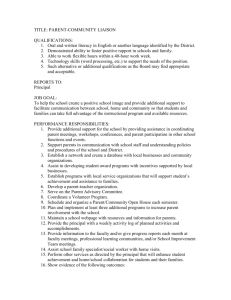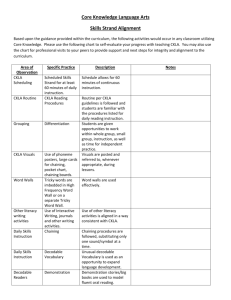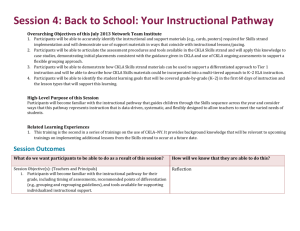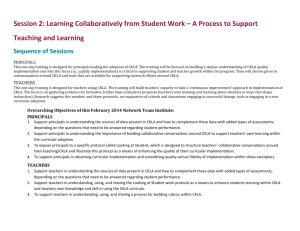Understanding Your Instructional Pathway
advertisement
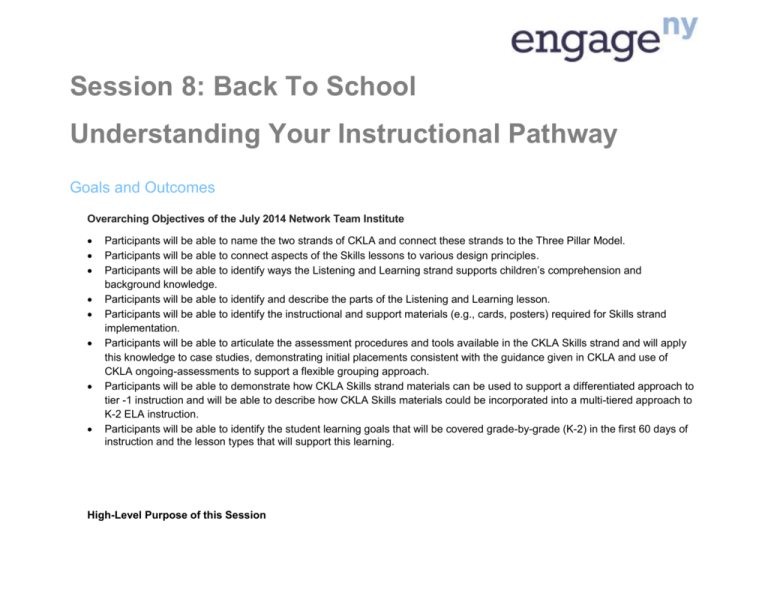
Session 8: Back To School Understanding Your Instructional Pathway Goals and Outcomes Overarching Objectives of the July 2014 Network Team Institute Participants will be able to name the two strands of CKLA and connect these strands to the Three Pillar Model. Participants will be able to connect aspects of the Skills lessons to various design principles. Participants will be able to identify ways the Listening and Learning strand supports children’s comprehension and background knowledge. Participants will be able to identify and describe the parts of the Listening and Learning lesson. Participants will be able to identify the instructional and support materials (e.g., cards, posters) required for Skills strand implementation. Participants will be able to articulate the assessment procedures and tools available in the CKLA Skills strand and will apply this knowledge to case studies, demonstrating initial placements consistent with the guidance given in CKLA and use of CKLA ongoing-assessments to support a flexible grouping approach. Participants will be able to demonstrate how CKLA Skills strand materials can be used to support a differentiated approach to tier -1 instruction and will be able to describe how CKLA Skills materials could be incorporated into a multi-tiered approach to K-2 ELA instruction. Participants will be able to identify the student learning goals that will be covered grade-by-grade (K-2) in the first 60 days of instruction and the lesson types that will support this learning. High-Level Purpose of this Session Participants will become familiar with the instructional pathway/pacing of instruction and ways that this pathway is data driven systematic, while also flexible for supporting children’s varied needs. Related Learning Experiences This two day training is designed as a curricular kick-off to support teachers who plan on implementing Core Knowledge Language Arts (CKLA) in the coming school year. While this training module is a new launch, individuals who have participated in previous CKLA sessions can use this as a regrounding opportunity. This module will not extend beyond the content of previous trainings. Session Outcomes What do we want participants to be able to do as a result of this session? In this session participants will: 1. Become familiar with the instructional pathway for their grade, including timing of assessments, recommended points of differentiation (e.g., grouping and regrouping guidelines), and tools available for supporting individualized instructional support. How will we know that they are able to do this? Participants will demonstrate understanding through discussion and reflection exercises. Session Overview Section Time Overview Prepared Resources Section 1. 15-20 The Instructional Pathway minutes Instructors will present the July2014_Teachers_Session8 instructional pathways document __InstructionalAssessmentPat for each grade-level, which is a hway_Kindergarten two page graphic that illustrates July2014_Teachers_Session8 the key decisions through the first __InstructionalAssessmentPat 60 days of instruction, including hway_Grade1 placement, grouping, ongoing July2014_Teachers_Session8 assessment and shows the __InstructionalAssessmentPat ‘intersection’ points hway_Grade2 July2014_Teachers_Session8 __InstructionalAssessmentPat hway_ARG_Overview This will be framed as the roadmap for the remaining sessions Section 2 15 Reflection minutes REFLECTION: (individual). Participants will reflect upon their instructional pathway to note clarifications and questions: How does this document clarify the ‘route’/pace/ path of instruction? What questions remain? July2014_Teachers_Session8__I nstructionalAssessmentPathway_ Reflection Facilitator’s Preparation Session Roadmap Section 1: The Instructional Pathway Time 12:3012:50 Slide #/Pic of Slide Slide 1 Time: 15-20 minutes Script/Activity directions Key Points: 1. Today, the focus is to support the procedures and practices that surround use of the materials for high quality/high-fidelity implementation. Grouping Slide 2 Slide 3 Key Points: 1. PREPARE participants for the principles that are reflected in their “Instructional Pathway” handout. 2. Data-based: Meaning children’s instructional path is determined by data ‘trends’ using curricular based assessments (end of unit assessments) and formal placement tests in 1st and 2nd 3. Explicit: Meaning the emphasis is on mastery and filling holes explicitly to support successful acquisition Individualized: Meaning all along the instructional path is an ongoing dialogue about how to support and enrich the experiences so children can use the materials in the ways that are best suited to their skills. Key Points: 1. INTRODUCE the “Instructional Path” handout: 2. Help participants orient to this document. 3. The middle column is the instructional pathway, meaning key decision points are highlighted as you move children through the curricular materials. 4. The left side reflects the ‘ongoing conversation’ that occurs between the curricular path and the strategies CKLA has built in for added support to struggling or vulnerable students. 5. The right side reflects the ‘ongoing conversation’ that occurs between the curricular path and the approaches to extension that you may consider for stronger students. 6. We recommend you start with the middle column and read through, then read the Support column, then read the Enrichment column. HANDOUT: Provide the [grade-level] Instructional and Assessment Pathway handout. We recommend giving participants their own grade’s pathway for examination. Ask administrators to choose a grade. Slide 4 Key Points: 1. Data-based: Describe at least two ways that the Instructional Path represents data-based instruction. 2. Explicit and Systematic: Describe how the instruction is explicit and follows a systematic scope and sequence and still can be flexible. 3. Individualized Support : Describe at least two strategies for supporting children’s varied skill levels. Slide 5 Key Points: 1. Locate your grade-level pathway on the specified pages. 2. Work with a partner(s) to examine the pathway through your assigned lens. 3. Answer the reflective questions. Slide 6 Key Points: 1. Starting with the table members who examined (1) data based instruction; share your findings with your table. 2. Repeat process with table members who examined the (2) systematic scope and sequence and (3) strategies to provide support. Section 2: Reflection Time 12:501:05 Slide #/Pic of Slide Slide 7 Time: 15 minutes Script/Activity directions Key Points: 1. What were your key findings? 2. How can you use this when you begin implementing the program? Turnkey Materials Provided July2014_Teachers_Session8__InstructionalAssessmentPathway_PPT Grouping






